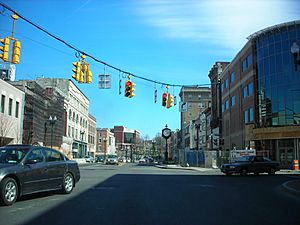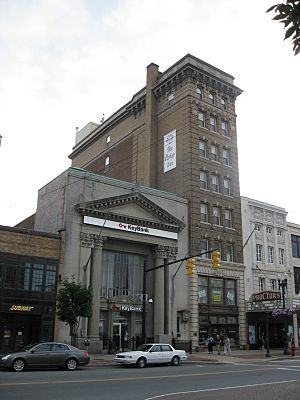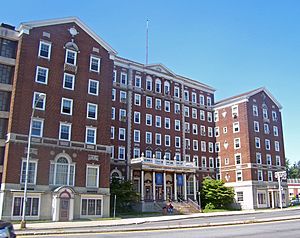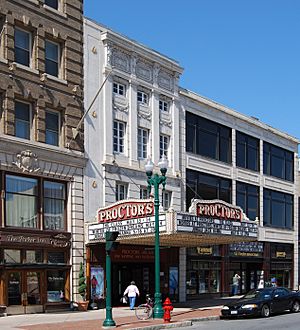Downtown Schenectady facts for kids
Quick facts for kids
Downtown Schenectady
City of Schenectady
|
|
|---|---|
|
Neighborhood/Central business district
|
|

State Street looking east in 2007, during the height of new construction
|
|
| Country | United States |
| State | New York |
| Region | Capital District |
| County | Schenectady County |
| Settled | 1820s |
| Area | |
| • Total | .53 sq mi (1.4 km2) |
| Population
(2000)
|
|
| • Total | 3,915 |
| • Density | 7,390/sq mi (2,852/km2) |
| Time zone | UTC-5 (Eastern Standard Time) |
| • Summer (DST) | UTC-4 (Eastern Daylight Time) |
| ZIP Code |
12305
|
| Area code | 518 |
| Website | Downtown Schenectady Improvement Corporation Metroplex Development Authority |
Downtown Schenectady is the busy heart of Schenectady, a city in New York. It started growing in the 1820s. Businesses moved here because of the new Erie Canal. This area was once home to huge companies like General Electric and American Locomotive Company. Thousands of workers came here every day.
Like many old industrial cities, Downtown Schenectady faced tough times in the 1970s. But thanks to new buildings and renovations, it's now a fun place to visit. Proctor's Theatre is a major attraction.
Contents
A Look Back in Time: Downtown Schenectady's History
The Downtown Schenectady area began to develop after a big fire in 1819. This fire destroyed many buildings in the old Stockade neighborhood. The Stockade was the first part of Schenectady settled in the 1600s.
After the fire, the Erie Canal was being built nearby. This made businesses want to move east to what is now Downtown. The Stockade then became more of a residential area.
Early Growth and Important Colleges
Union College, a private four-year college, was founded in 1795. In 1806, the college bought a large piece of land east of the main town. This land was described as "pasture grounds" with swamps and sand hills.
The Mohawk and Hudson Railroad was built in 1831. It was the first steam passenger train service in the United States. This railroad offered an alternative to the Erie Canal. The current train tracks opened in 1843.
The Rise of Industry: GE and ALCO
Thomas Edison moved his Edison Machine Works to Schenectady in 1887. In 1892, it became the main office for General Electric (GE). The GE plant was located at the west end of Downtown.
The American Locomotive Company (ALCO) also had its plant and headquarters downtown. ALCO was active from 1848 to 1970. Thousands of workers from both GE and ALCO supported businesses along State Street.
ALCO was a leader in many industries. They started with steam trains and moved to electric and diesel-electric trains. Many important products came from ALCO's Schenectady plant. This included the first diesel-electric train in 1924. They also built the world's largest train in 1941. During World War II, they made tanks and parts for the US Navy. By the late 1940s, about 80% of all diesel-electric trains in the US were built here.
Because of these industries, Schenectady earned the nickname "The City that Lights and Hauls the World."
Challenges and Renewal Efforts
In the late 1970s, there were efforts to improve Downtown. Money was used to upgrade Mill Street. Two restaurants opened there, but they later closed. The project didn't succeed.
Another attempt was the $11 million Canal Square shopping plaza in the 1980s. Even President Ronald Reagan praised it. But it failed because of competition from suburban malls. There was even a plan to tear down Proctor's Theatre for a mall, but it never happened.
In the 1980s, GE reduced many jobs in Schenectady. When GE moved its Power Systems division headquarters, the city took action. They created the Metroplex Development Authority. This group helps fund private projects with grants and loans.
Downtown's Comeback: A New Beginning
The early 2000s saw a big revival in Downtown Schenectady. Many new and old businesses moved in or expanded. Much of this success is thanks to the Metroplex Development Authority.
One early project was the MVP Health Plan headquarters in 2001. Metroplex paid for an $11 million parking garage next to it. They also helped renovate 411 State Street. This space became a Paul Mitchell retail store and training school.

The renovation of Proctor's Theatre in 2007 was a major turning point. The renovation cost $30 million. It added new theaters and an expanded backstage area. This allowed Proctor's to host bigger Broadway shows. Before the renovation, Proctor's had 150,000 visitors in 2004. Five years later, in 2009, it had 500,000 visitors.
A former 100-year-old bank building next to Proctor's is also being expanded. It will be used for events like banquets and weddings. It's called the Key Hall at Proctor's. A movie theater, Bow Tie Cinema, was also built nearby.
In 2010, the city's Center City Sportsplex was rebuilt as a new YMCA branch. The Golub Corporation, which owns Price Chopper Supermarkets, moved downtown in 2010. They chose a former ALCO site that needed a lot of cleanup. State and federal funds helped with the costs. Also in 2010, SEFCU (State Employee Federal Credit Union) moved some operations downtown.
These changes have improved Downtown's image. A 2008 survey showed that 80% of county residents visit Downtown. 82% said they had a better view of the area. In 2007, U.S. News & World Report wrote about Schenectady's industrial past and decline. Mayor Brian Stratton responded by highlighting the $150 million invested in Downtown. This included new theaters, hotels, restaurants, and offices. Redevelopment continues today, especially along State Street.
Who Lives Here: Downtown Demographics
In 2010, Downtown Schenectady had 4,139 people living there. This was a 15.8% increase from 1990. There are 1,582 homes in the neighborhood. On average, 3.48 people live in each home. Most homes (90.8%) are rented, while 10.2% are owned.
The average age in Downtown is 24.9 years old. This makes it the youngest neighborhood in the city. Between 1990 and 2000, the number of school-aged children grew by 143.2%. The number of adults grew by less than 1%.
The average income for Downtown residents was $18,939 in 2010. Many residents (38.2%) live below the poverty level. About 51.9% of the residents are minorities.
Exploring the Area: Downtown Geography
Downtown Schenectady covers about 340 acres (140 ha). It is in the northwestern part of Schenectady. The Stockade neighborhood and the Mohawk River are to the west.
 |
Stockade | Mohawk River | Northside |  |
| Mohawk River/Town of Glenville Village of Scotia |
Union Street | |||
| Bellevue General Electric plant |
Hamilton Hill |
How Land is Used in Downtown
About 43% of Downtown's land is used for community services. Commercial properties make up 32%. Apartments and public services use about 5% of the land. Most homes (66.6%) were built before 1940. About 7% of the land downtown is empty.
A large part of Downtown (69%) is tax-exempt. This is because of the many colleges and government buildings. These include Schenectady County Community College and Union College.
Many buildings in Downtown Schenectady are on the National Register of Historic Places. These include the Schenectady City Hall, the Schenectady Post Office, and Proctor's Theatre. The block near Jay, Liberty, Broadway, and Franklin streets became a historic district in 2006.
Getting Around: Transportation in Downtown
The main roads in Downtown Schenectady are State Street, Erie Boulevard, and Broadway. The Western Gateway Bridge carries NY Route 5 (State Street) over the Mohawk River to the village of Scotia.
Interstate 890 is at the western edge of Erie Boulevard. It connects Downtown to the New York State Thruway. Downtown Schenectady has an Amtrak train station. It also has a bus station served by Greyhound Lines.
Fun and Games: Recreation in Downtown
Downtown Schenectady has three parks. These are South Avenue Park, Liberty Park, and Veteran's Park. Liberty Park and Veteran's Park are quiet parks with memorials. South Avenue Park is a .35-acre (0.14 ha) park with a basketball court and playground.
There is a YMCA on State Street. It has exercise equipment, a spin studio, and a sauna. It also has a basketball court for the Schenectady County Community College teams.
What to Do: Entertainment in Downtown
Proctor's Theatre is one of the top entertainment spots in the Capital District. It hosts over 600 events each year. You can see Broadway plays, concerts, and opera here. Proctor's also has a farmer's market and shows movies. They even offer summer camps for kids on topics like jazz and filmmaking.
Jay Street is a pedestrian street that links State Street to City Hall. It has about 20 businesses, including shops, bookstores, and restaurants. Jay Street Studios offers affordable space for artists. It also has the Schenectady Museum's gift shop.
Downtown Schenectady hosts many cultural events. These include the Urban Arts Show and Jazz on Jay, a free concert series. The annual Schenectady County SummerNight has live music, carnival games, and fireworks.
Learning Hub: Education in Downtown

Downtown Schenectady is home to two colleges. Schenectady County Community College is a two-year college. Union College is a private four-year college. In 2003, Union Graduate College became an independent college. It opened its own location downtown in 2009. This spot was once Schenectady High School.
The main branch of the Schenectady County Public Library is downtown. In 2010, it underwent a $2.6 million expansion. This added a new children's room and modern technology.




